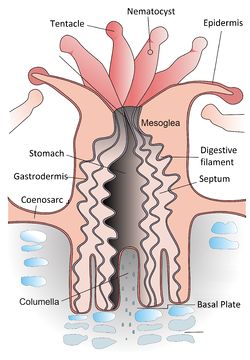CoralPolyps: Difference between revisions
No edit summary |
No edit summary |
||
| Line 10: | Line 10: | ||
[[File:Coral polyp anatomy.jpg|right|250px|diagram of the polyp of a stony coral]] | [[File:Coral polyp anatomy.jpg|right|250px|diagram of the polyp of a stony coral]] | ||
Coral polyps are multicellular organisms with limited organ development. The average polyp grows to 1-3mm in diameter and can exist as a solitary individual or as a group of interconnected polyps called a colony. Corals are categorized as scleractinian, or hard corals, or Alcyonacea, or soft corals depending on whether or not they produce a calcium carbonate skeleton. | |||
Corals that create a rigid calcium carbonate skeleton are the hard corals. These are the primary corals involved in reef building and are termed hermatypic. Typically, scleractinian coral polyps are characterized as having sets of six tentacles, septa, and mesenteries. The tentacles encircle the mouth and are used in defense and the capturing of prey. They contain stinging cells called nematocysts. These poison-injecting are used to incapacitate small prey, as well as deterring predators. The mouth is the only opening to the gastrovacular cavity and is used to ingest food and expel waste. The gastovascular cavity contains mesenteries, which internal folds that increase the surface area of the stomach. The mesenteries are supported by the septa. | |||
*Describe the different parts that make up the Polyp and what they do. (Tentacle, mouth, basal plate, etc.)<ref name="Pechenick"> Pechenik, J. A. . Biology of the invertebrates. sixth. McGraw-Hill, 2010. print. | *Describe the different parts that make up the Polyp and what they do. (Tentacle, mouth, basal plate, etc.)<ref name="Pechenick"> Pechenik, J. A. . Biology of the invertebrates. sixth. McGraw-Hill, 2010. print. | ||
Revision as of 15:02, 1 April 2014
Coral Polyps
Corals belong to the Ppylum Cnidaria and class Anthozoa. Corals exist as individual polyps or in colonies.[1].
- talk about what a Polyp is and where they are found [2]
Anatomy

Coral polyps are multicellular organisms with limited organ development. The average polyp grows to 1-3mm in diameter and can exist as a solitary individual or as a group of interconnected polyps called a colony. Corals are categorized as scleractinian, or hard corals, or Alcyonacea, or soft corals depending on whether or not they produce a calcium carbonate skeleton.
Corals that create a rigid calcium carbonate skeleton are the hard corals. These are the primary corals involved in reef building and are termed hermatypic. Typically, scleractinian coral polyps are characterized as having sets of six tentacles, septa, and mesenteries. The tentacles encircle the mouth and are used in defense and the capturing of prey. They contain stinging cells called nematocysts. These poison-injecting are used to incapacitate small prey, as well as deterring predators. The mouth is the only opening to the gastrovacular cavity and is used to ingest food and expel waste. The gastovascular cavity contains mesenteries, which internal folds that increase the surface area of the stomach. The mesenteries are supported by the septa.
- Describe the different parts that make up the Polyp and what they do. (Tentacle, mouth, basal plate, etc.)[3]
- Explain how nerve cells loosely connect Polyps to one another creating a nerve net between a colony of Polyps
Symbiotic relationship with zooxanthellae
- Define symbiosis.
- Explain how Polyps and Zooxzanthellae have a symbiotic relationship. (what each does for each other)[1]
- Explain how through this relationship both are mutually benefited.
- Explain how the relationship is also obligative. Meaning that, in most cases, neither can live without the other.
Stony Coral and Soft Coral Coral
- Stony corals make a calcium carbonate skeleton, soft corals do not do this
Feeding
- How Polyps are able to use their tentacles to pull in zooplankton and small fish to their mouths
Reproduction
- Explain the process of reproduction
References
- ↑ 1.0 1.1 NOAA, NOAA Coral Reef Conservation Program Coral 101. NOAA. Web. 5 Mar 2014. <http://coralreef.noaa.gov/aboutcorals/coral101/>.
- ↑ Gray, Susan Heinrichs. Coral Reefs. Minneapolis, Minn: Compass Point Books, 2000. eBook Collection (EBSCOhost). Web. 22 Feb. 2014.
- ↑ Pechenik, J. A. . Biology of the invertebrates. sixth. McGraw-Hill, 2010. print.